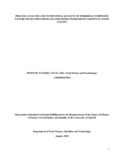| dc.description.abstract | High malnutrition in Nandi County has created the need for utilization of ''nutrient strength''of locally available ingredients in development of a number of multi cereal-legume based composite flour by farmers groups. However, process optimization, consumer preference and acceptability, product safety and nutritional quality of these flours has not been done. This has created the gap in knowledge on the best processing technology and ratio combination of ingredients to ensure nutrients optimization targeting specific demographics. Hence the current study aimed at process optimization, safety and quality analysis and development of most acceptable composite porridge flours using locally available ingredients at Nandi County.
Structured interviews and intervention was done with two farmers groups (Kapkerer and Kiptaruswo) currently involved in composite porridge flour development. A cross-sectional study was done to determine farmers’ and consumers’ inclination to ingredients used in porridge flour development and to evaluate the processing protocol followed in porridge flour development. Data was collected through focused group discussion, observation and individual interview. Samples obtained from respective farmers groups were used for the study and included; legumes (soybean, groundnut and lablab), cereals (wheat, sorghum, finger millet and maize), pseudo-cereals (buckwheat, amaranth seed and pumpkin seed) and roots (cassava and arrowroot). Nutritional profiling of each ingredient was done as per standard methods. Tannins and phytate reduction in selected grains was achieved by processing technologies like soaking, roasting and boiling. Nutrisurvey linear programming software was used in composite flour formulations and nutrient optimization. The formulated flours were subjected to sensory analysis and acceptability studies. Further, nutritional and anti-nutritional profiling was done for the most accepted composite flour and their control. The most accepted porridge flours and their controls were packaged in kraft paper, gunny bag and plastic container and subjected to Accelerated Shelf Life study (ASLT).
Findings from consumers and farmers inclination to ingredients used in composite flour indicated higher preference of soybean, groundnut, sorghum, finger millet and cassava. This was influenced by the cultural importance attached to specific ingredients, cost, availability and their impact on the sensory attributes of porridge. The processing protocol followed by farmers’ groups was inadequate in meeting safe and nutritious products. Legumes and pseudo-cereals were found to be the most nutritious in protein (9.78-41.14%), fibre (7.54-13.70%) and fat (5.70-38.14%). Observed optimal processing treatment included; soaking groundnut, finger millet and soybean for 6 hrs at 1:2 soaking ratio and soaking lablab for 24 hrs at 1:3 soaking ratio and boiling for 60 mins. Consumer acceptability and preference studies showed that the new formulations were the most preferred on color (20-54.2%), smell (40-52.4%), taste (45-47.5%), texture (30-58.3%), viscosity (35.4-45.8%) and overall acceptability (35-54.2%). Reduction of fat content in new formulation while optimizing on nutrient density was achieved. The new formulations were found to degrade slower on safety and quality attributes more so in plastic jars. All the formulations would therefore be kept for more than five months with plastic jars being the best packaging material. Therefore, locally available ingredients are thus nutritious enough to meet with nutritional requirement of vulnerable target groups more so, if properly processed and packaged. Thus if the farmers’ group would adopt the observed processing protocols in developing the most acceptable composite flour, there would be customer satisfaction which would create more demand for their product thus reducing malnutrition among children while economically empowering the farmers. | en_US |

